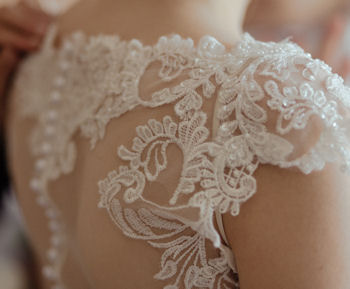All About Lace - for your wedding gown
Categories: | Wedding Attire |
 Lace and weddings go together like, well,
wedding gowns and weddings. Regarded to be the
traditional bridal fabric, lace has been popular for
luxury wedding gowns for centuries. It has kicked off an
enduring fashion choice (enter Queen Victoria and her
lace-trimmed white gown), it has revived local industry,
it has been used as the main fabric and as a trim.
Lace and weddings go together like, well,
wedding gowns and weddings. Regarded to be the
traditional bridal fabric, lace has been popular for
luxury wedding gowns for centuries. It has kicked off an
enduring fashion choice (enter Queen Victoria and her
lace-trimmed white gown), it has revived local industry,
it has been used as the main fabric and as a trim.What is lace?
out
Lace is a decorated fabric that is made either on a
background fabric of net or with no background fabric.
Today it is used both as an all over fabric and as an
appliqued decoration.Handmade or machine-made?
out
Way back when lace was a luxury fabric it was always
made by hand. Today it is largely machine made, and many
of the patterns (usually floral) imitate the hand-made
originals. Understanding how much handwork goes into a
type of lace and how intricate the design will give you
a clue to how expensive it is. Expect to pay hundreds or
even thousands of dollars per metre for the most
intricate laces.Here are some of the major
types of lace used in wedding gowns:
out
- All over lace. The pattern covers the entire fabric, rather than being isolated on one section of background net.
- Ajour lace. A very open lace design with the pattern scattered on the ground.
- Alençon lace. Lace made on a sheer net fabric with a solid design that is outlined by cord.
- Antique lace. A heavy lace made on a square knotted net with designs darned onto the net. Machine made antique lace is usually used for curtains but I have seen it used in wedding gowns
- Argentan lace. Somewhat similar to Alençon lace but the designs are usually not outlines with cord. The designs are also often larger and bolder than those of Alençon lace.
- Belgian lace. Any lace made in Belgium! However, originally it meant a bobbin lace worked on a machine made net.
- Binche lace. Handmade lace motifs are appliqued onto a machine-made net ground.
- Bobbin lace. Lace made using a pillow to hold pins around which thread is arranged. Bobbins are used to hold and feed the thread. Not generally used for yardage, but for features such as collars and cuffs.
- Bourdon lace. Machine made lace, usually in a scroll design with the design outlined with a heavy thread.
- Breton lace. Lace made on open net, usually embroidered with very heavy coloured yarns.
- Brussels lace. May be either a bobbin lace or a needlepoint lace. It is usually worked on a machine-made ground and sometimes the designs are appliqued on.
- Chantilly lace. Lace made on a fine, six-sided mesh background and elaborate patterns, often floral designs. It is popular for lingerie, and is often used for trimming veils. Made by the bobbin method, the designs are outlined by thick cords.
- Cluny lace. The traditional lace for doilies and place mats it is also used for very structured garments, such as suits. It is heavy, made of thick cotton or man-made fibres using the boobin method.
- Crocheted lace. Most often used for a Boho style wedding dress. It is made with a single yarn using a crochet hook to form loops which are joined to other loops to form the design.
- Guipure lace. A type of bobbin lace in which the motifs are made of large corded yarns and are connected with bars or plaits (called brides or bridges) rather than net or mesh.
- Honiton lace. A type of bobbin lace in
which the motifs are made separately and then sewn
onto a net base. It hasn't been made commercially
since 1940, but there are still some enthusiasts who
produce it non-commercially. But you will often see
references to it because it was the lace Queen
Victoria had on her wedding dress and that choice
was credited with saving the lace industry in Devon.
- Irish lace. Strictly speaking, a heavy, crocheted lace with a square mesh background, but nowadays any lace made in Ireland, but generally either crocheted lace or embroidered net. Often ornamented with rose or shamrock medallion motifs.
- Needlepoint lace. Lace made with a sewing or embroidery needle to form buttonhole stitches as the basis of the design.
- Re-embroidered lace. Lace with the designs outlined with embroidery stitching.
- Tatting. Generally used for edging veils. A narrow, knotted lace worked with fingers and a shuttle that holds the thread.
- Valenciennes lace (sometimes called Val lace). A flat bobbin lace worked with one thread forming both the background and the design for the lace.
- Venise lace (sometimes called Venetian or Venice lace). A needlepoint lace usually having a floral pattern connected by picot edging.
Lining choice is important
out
What your designer chooses as a lining fabric can make a
world of difference, and not just to the level of
modesty it affords. Lining affects comfort, drape (how
soft or stiff your dress is) as well as how it looks and
how loud it might be. Some fabrics can rustle loudly
when you move!Related information
o
Thanks for reading!
